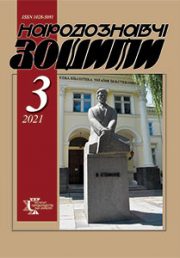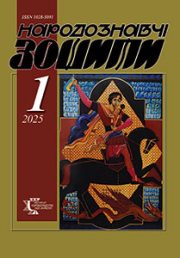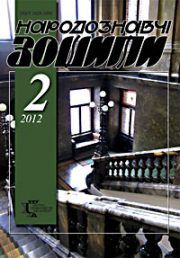The Ethnology Notebooks. 2019, № 4 (148), 878—897
УДК 398.8(=161.2:478-22)”187/20″
DOI https://doi.org/10.15407/nz2019.04.878
KHARCHYSHYN Olga
ORCID ID: https://orcid.org/0000-0002-9379-8300
Candidate of Philological Sciences (Ph. D. in philology), Senior Researcher at the Ethnology Institute of National Academy of Sciences of Ukraine,
15, Svobody Avenue, 79000, Lviv, Ukraine.
Contacts: е-mail: okharchyshyn@gmail.com
PASTUKH Nadiia
ORCID ID: https://orcid.org/0000-0001-7703-5541
Candidate of Philological Sciences (Ph. D. in philology), Senior Researcher at the Ethnology Institute of National Academy of Sciences of Ukraine,
15, Svobody Avenue, 79000, Lviv, Ukraine.
Contacts: е-mail: npastukh@gmail.com
KOVAL Vasyl
ORCID ID: https://orcid.org/0000-0002-3562-8899
Candidate of Art (Ph. D), Senior Researcher at The Mykola Lysenko
Lviv National Music Academy,
5, Ostap Nizhankivsky str., 79000, Lviv, Ukraine.
Contacts: е-mail: vmk333@ukr.net
Abstract. The article presents the analysis of the current state of the functioning of calendar ritual folklore in the Ukrainian villages of the Republic of Moldova. The research was conducted mainly on the basis of the materials of folklore records that were carried out in 43 villages and 1 city of 10 districts of the Republic of Moldova (in places of compact residence of Ukrainians) during integrated scientific expeditions of the Institute of Ethnology of the National Academy of Sciences of Ukraine (2005—2007) and personal expeditions (2008—2009, 2016). The analysis also included a comparison of our fixations of folklore with available printed records of predecessors, which appeared in print from the 1870’s. XIX century. The relevance of the article is due to the lack of tangible interest from the Ukrainian ethnological and folklore science in the traditional ritual and folklore culture of Ukrainians in Moldova, and consequently in the absence of works that would present ceremonial folklore (in particular, calendar ceremonial folklore) as a locally-regional integrity, ascertained by all-Ukrainian and local traits, traced the dynamics of changes in the genre system of folklore, in its repertoire, ritual context, and others like that. The object of the research is the texts of calendar ritual folklore (carol and shchedrivka, malanka song, parovanka, heykaniya, vesnyanka, Kupala song), which are common in the Ukrainian villages of Moldova, and the subject is the modern state of the existence of such texts. The purpose of the article is to trace the state of preservation and functioning of traditional calendar ceremonial folklore, namely the dynamics of changes in the genre system, repertoire filling, ritual context, and peculiarities of execution. The research is based on the methodological foundations of locally-regional study of folklore, which were outlined in the writings of V. Hnatyuk, F. Kolessa, S. Myshanych, R. Kyrchiv and others.
Keywords: ceremonial folklore, functioning, Ukrainians of Moldova, carols, shchedrivki, malanka songs, heykaniya, parovanka, vesnyanka, kupala songs.
Received 13.07.2019
REFERENCES
Kharchyshyn, O. (2015). Some facts of the history of studies in Moldavian Ukrainians’ folklore (1870—1930). The Ethnology Notebooks, 2, 370—376 [in Ukrainian].
Kharchyshyn, O. (2015). Research of Ukrainian-Moldovan ethno-cultural relations in Soviet folklore: modern reading In Ukrainian-Moldovan ethnocultural relations. International symposium and memoriam of the academician Konstantin Popovich (Vol. I, pp. 321—329). Chisinau [in Ukrainian].
The village is singing and dancing. From the history and folk poetry of the village of Petrunya-Glode. (1995). Chisinau [in Romanian].
Popovych, K., Cherneha, K., Myronenko, Y. & Pan’ko, V. (Eds.). (1995). Sturzovka is singing. Collection of Ukrainian and Moldavian folklore from v. Sturzovka of Glodens’ky district of Moldova. Chisinau [in Ukrainian].
Our roots are in the land. The history, traditions and folklore of the villages of Danu, Kamenkuts and Nikolaevka of the Glodeni district. Research and materials. (1997). Chisinau [in Russian].
Kharchyshyn, O. (2018). Pan’ko Victor Dmytrovych. In Ukrainian folkloristic encyclopedia (pp. 578—579). Lviv [in Ukrainian].
Kozhuhar’, V.H. & Kozhuhar’, K.S. (2015). (Eds.). Ukrainian-Moldavian ethnocultural relations. International symposium and memoriam of the academician Konstantin Popovich. Сollection of scientific works (Vol. 1). Chisinau [in Ukrainian].
Kozhuhar’, V.H. & Kozhuhar’, K.S. (2016). (Eds.). Ukrainian-Moldavian ethnocultural relations. International symposium and memoriam of the academician Konstantin Popovich. Сollection of scientific works (Vol. 2). Topical issues of the history, language and culture of the Ukrainians of the Republic of Moldova. Chisinau [in Ukrainian].
Kharchyshyn, O. (2018). Ukrainian-Moldavian ethno-cultural relations: achievements of scientific cooperation. The Ethnology Notebooks, 3, 767—770. Review: Kozhuhar’, V.H. & Kozhuhar’, K.S. (2015). (Eds.). International symposium and memoriam of the academician Konstantin Popovich. Сollection of scientific works (Vol. 1). Chisinau. Kozhuhar’, V.H. & Kozhuhar’, K.S. (2016). (Eds.). International symposium and memoriam of the academician Konstantin Popovich. Сollection of scientific works (Vol. 2). Topical issues of the history, language and culture of the Ukrainians of the Republic of Moldova. Chisinau [in Ukrainian].
Kryms’kyi, А. (2012). Harvest. The Ethnology Notebooks, 2, 353—360 [in Ukrainian].
Hnatiuk, V. (Ed.). (1914). Christmas Carols and Epiphany Carols. In Ethnographic Collection (Vol. I—II). Lviv [in Ukrainian].
Sumtsov, N.F. (1888). Essays on the history of South-Russian apocryphal tales and songs. Kyiv [in Russian].
Kuznetsova, V.S. (1998). The plot of the creation of the world by two pigeons in the Galician carol and dualistic legends about peacemaking. In Kuznetsova V.S. Dualistic Legends of the Creation of the World in the East Slavic Folklore Tradition. Novosibirsk. Retrieved from: https://www.twirpx.com/file/1758719/ (Last accessed: 16.04.2013) [in Russian].
Tvorun, S. (2007). Christmas carols during harvesting. The Ethnology Notebooks, 3—4, 37—39 [in Ukrainian].
Kharchyshyn, O. & Pastukh, N. (2013). Folklore of the Ukrainians of Moldova as inseparable part of Ukrainian oral folk tradition (on the example of Christmas carols of archaic form) In The Kolessas: the Succession of Scholarly and Artistic Traditions (Dedicated to the 140-th Birth Anniversary of the Academician Philaret Kolessa): A collection of scholarly papers and materials (pp. 165—178.). L’viv: Ivan Franko National University of Lviv [in Ukrainian].
Hoshovskyi, V. (1971). In the core of Slavonic folk music: essays on musical slavistics. Moscow: Soviet Composer [in Russian].
Caraman, P. (1933). The ritual of caroling at the Slavs and Romanians. Comparative study. In Polish Academy of Arts and Sciences. Works of Commission on Ethnography (Vol. 14). Cracow [in Polish].
Kharchyshyn, O. (2014). Malanka songs by Ukrainians of Northern Moldova: poetic aspect (reinterpretation of motives). The Ethnology Notebooks, 3, 514—529 [in Ukrainian].
Kozhuhar, K. & Kozhuhar, V. (2016). «Nisenito» and «Trikry» as regional variants of the New Year’s ritual complex «Malanka» In Ukrainian-Moldavian ethnocultural relations. International symposium and memoriam of the academician Konstantin Popovich (Vol. 2, pp. 101—132). Chisinau [in Ukrainian].
Kozholyanko, A. (2016). «Malanka» in the New Year ritual of Moldavians and Romanians in Bukovina. In Ukrainian-Moldavian ethnocultural relations. International symposium ad memoriam of the academician Konstantin Popovich (Vol. 2, pp. 84—100). Chisinau [in Ukrainian].
Kurochkin, O. (1995). Ukrainian New Year Rites: «A Goat» and «Malanka» (from the history of folk masks). Opishne [in Ukrainian].
Zawoychinskyi, V. (1880). Lenkovtsy village of Khotyn: historical and statistical description. Religion and superstitions. Kishinevskie eparhial’nye vedomosti, 15, 640—653 [in Russian].
Pan’ko, V. (2009). Song folklore of Ukrainians of the North of the Republic of Moldova. Calendar and ritual poetry. Chisinau [in Russian].
Dykarev, M. (Ed.). (1918). Meeting of rural youth in Ukraine. In Materials to Ukrainian Ethnology (Vol. 18, pp. 210—226). Lviv [in Ukrainian].
Klymets’, Yu.D. (1990). Kupala ceremony in Ukraine. Kyiv: Scientific Opinion [in Ukrainian].
Kharchyshyn, O. (2005). Folk song tradition of Zvenigorod and its surroundings. In Folk song of Zvenigorod region near Lviv. Lviv [in Ukrainian].
Kharchyshyn, O. (2013). On St. Andrew’s eve pairing songs by Ukrainians of Northern Moldova: local, regional and national contents. The Ethnology Notebooks, 3, 387—397 [in Ukrainian].
Zubryts’kyi, M. (1900). Folk calendar, customs and beliefs related with the days of the week and the annual holidays (recorded in Mshanka of Staromysk district and in the neighboring villages). In Materiialy do ukrains’ko-rus’koi etnol’ogii (Vol. 3, pp. 33—60). Lviv [in Ukrainian].
Bostan, H.K. (1985). Typological correlation and interrelations of Moldavian, Russian and Ukrainian folklore. Chisinau: Shtiintsa [in Russian].
Mushketyk, L. (2013). Folklore of the Ukrainian-Hungarian borderland. Kyiv: Ukrainian writer [in Ukrainian].
Pastukh, N. (2014). Kupala ritual and songs in the Ukrainian villages of the Northern Moldova. Studia methodologica, 38, 93—98 [in Ukrainian].
Zaval’nyuk, A.F. (2008). Ukrainian summer ceremonials and songs. Vinnutsia: New book [in Ukrainian].
Primordial Rusava (ethnographic and folklore materials of v. Stina on Podillya). Vinnutsia Vinnytsia regional center of folk art [in Ukrainian].
Kamins’kyi, V. (1927). The Kupala ceremony in Volyn Polissya. In Ethnographic Herald (Vol. 5, pp. 11—23). Kyiv [in Ukrainian].
Dey, O. (Ed.). (1974). Ukrainian folk songs in the records of Zorian Dolenji-Khodakovsky (from Galychyna, Volyn’, Podillya, Prydnipryanshchyna and Polissya). Kyiv: Scientific Opinion [in Ukrainian].







